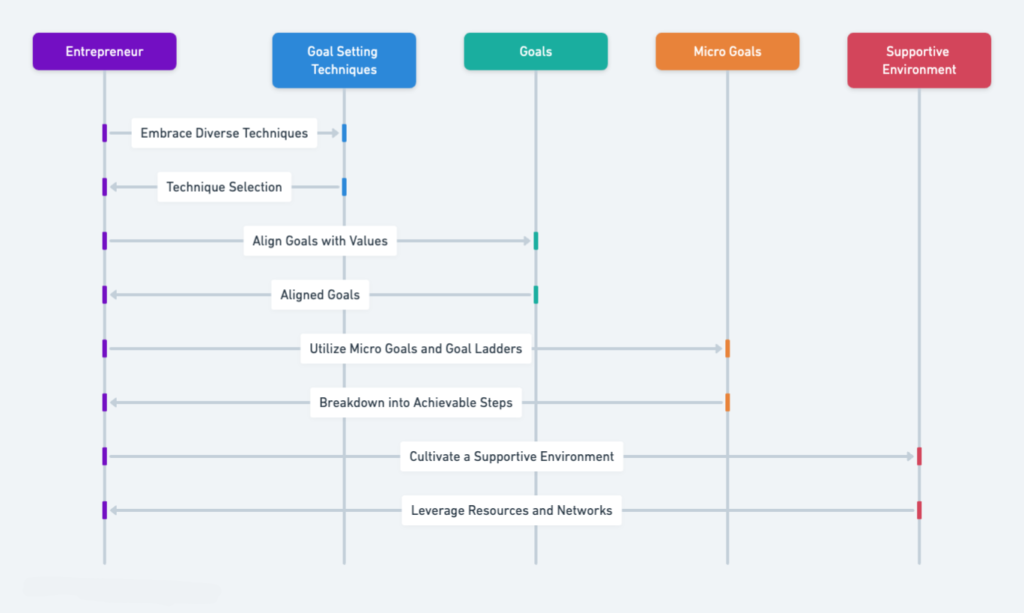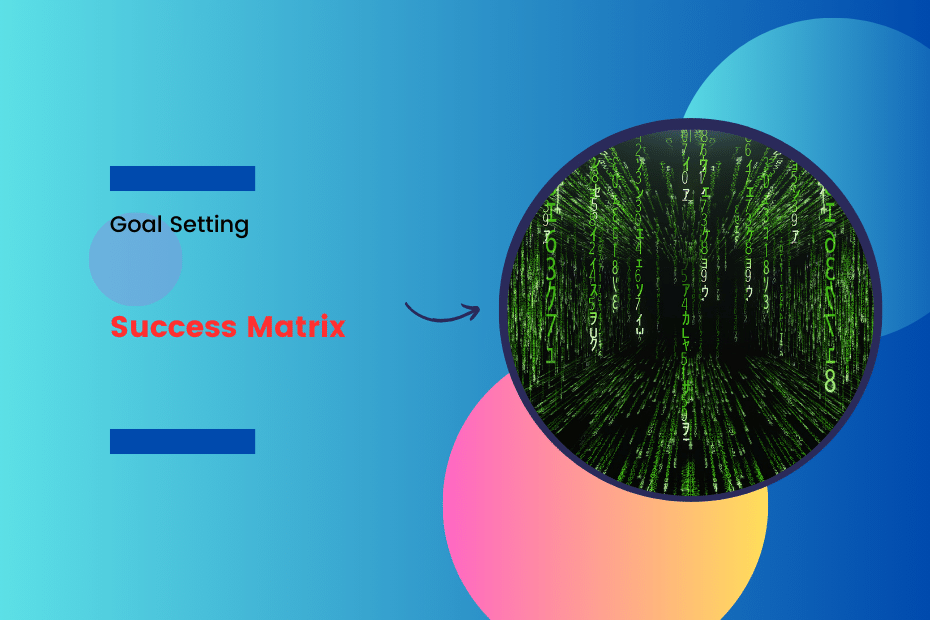Embarking on the entrepreneurial journey is an adventure filled with uncertainties and opportunities. At the heart of turning innovative ideas into thriving businesses lies the power of effective goal setting. More than just a task list, goal setting is a strategic compass that guides entrepreneurs through the tumultuous waters of business development. It’s about envisioning a future where your idea has transformed into a sustainable venture and charting a course to get there. This article aims to explore the multifaceted landscape of goal-setting techniques, providing you with a toolkit to create your own success matrix—a framework that not only helps in achieving milestones but also fosters innovation and sustainability.
The Mechanics of Goal Setting
At its core, goal setting is a systematic process that requires clarity, focus, and a strategic approach. Among the various techniques, SMART goals stand out for their simplicity and effectiveness. The SMART acronym—Specific, Measurable, Attainable, Relevant, and Time-bound—serves as a checklist to ensure that your goals have a clear objective, a way to measure progress, a realistic path to achievement, alignment with broader objectives, and a defined timeline. This method emphasizes the importance of crafting goals that are not only ambitious but also grounded in reality, offering a balanced approach to striving for success.
However, goal setting doesn’t stop at making them SMART. The real challenge lies in bringing these goals to life, transforming them from words on paper into tangible outcomes. This involves a deep understanding of your own motivations, the market landscape, and the resources at your disposal. It’s about bridging the gap between where you are now and where you want to be, leveraging the SMART criteria as a foundation for this journey. By setting goals that are both aspirational and achievable, entrepreneurs can navigate the complexities of business development with confidence, keeping their sights set on innovation and sustainability.
Beyond SMART: Expanding Your Goal-Setting Horizons
Embarking beyond the well-trodden path of SMART goals, entrepreneurs can discover expansive and visionary goal-setting frameworks like BHAGs (Big, Hairy, Audacious Goals) and WOOP (Wish, Outcome, Obstacle, Plan) that cater to broader aspects of business aspirations and challenges. BHAGs are designed to push the boundaries of conventional goal setting, encouraging entrepreneurs to think big and set long-term goals that are visionary and seemingly beyond reach. These goals are not just about growth but about inspiring and rallying the entire organization towards a unified and ambitious vision.
On the other hand, the WOOP framework integrates the power of positive thinking with the pragmatism of actionable planning. By identifying a Wish or goal, envisioning the Outcome, acknowledging potential Obstacles, and developing a Plan to overcome these hurdles, WOOP provides a balanced approach to goal setting that is both aspirational and grounded in reality. This method helps in converting dreams into achievable plans, ensuring that obstacles are not just identified but planned for, making the journey towards goal realization more structured and less daunting.
Creating Synergy and Adaptability
In the fast-paced and ever-evolving world of entrepreneurship, goals cannot be static or isolated. They must be synergistic and adaptable, capable of growing and evolving alongside the business. Synergistic goals ensure that each objective supports and enhances others, creating a cohesive strategy where the sum of achieving individual goals is greater than its parts. This interconnectedness ensures that efforts are not duplicated and that every action moves the business closer to its overarching ambitions.
Moreover, the adaptability of goals is crucial in today’s dynamic market environments. As entrepreneurs navigate through uncertainties and opportunities, goals that can evolve over time allow for responsiveness to new information, shifts in market dynamics, or changes in the business itself. Expansive goals are designed with the future in mind, flexible enough to grow and adapt as the entrepreneur’s capabilities and the external environment change. This flexibility ensures that goals remain relevant and aligned with the business’s trajectory, empowering entrepreneurs to pivot and adjust their strategies as necessary.
The Social Dimension of Goal Setting
The journey toward achieving goals is profoundly influenced by the social environment surrounding an entrepreneur. Social influences are a crucial determinant in both the selection and achievement of goals. Establishing a supportive network can significantly enhance one’s motivation and commitment to their objectives. This is especially true within team settings, where the dynamics of goal setting take on additional layers of complexity. Structural differences in goal setting for teams versus individuals highlight the necessity for clear communication and a shared vision. Research underscores the importance of agreement on team performance goals, which can lead to increased individual satisfaction and contributions towards the team’s objectives. In virtual teams, the concept of a ‘caretaker’—someone responsible for aligning team efforts—emphasizes the need for role clarity and collective progress towards shared goals.
Putting Theory into Practice: Strategies for Success

Translating goal-setting theories into tangible success requires a multifaceted approach:
- Embrace Diverse Techniques: Entrepreneurs should explore and utilize a variety of goal-setting techniques to discover those that best align with their venture’s unique needs. This exploration allows for the identification of methods that resonate with the entrepreneur’s vision and operational style.
- Align Goals with Values: It’s crucial to ensure that the goals set are in harmony with both personal and business values. This alignment fosters a sense of purpose and direction, guiding the entrepreneur towards meaningful and fulfilling achievements.
- Utilize Micro Goals and Goal Ladders: Breaking down overarching objectives into micro goals or employing goal ladders can significantly simplify the journey toward ambitious targets. This approach makes the process more manageable and provides frequent milestones that motivate continuous progress.
- Cultivate a Supportive Environment: Building an ecosystem that nurtures goal attainment is essential. This includes leveraging both internal resources, such as team skills and company culture, and external resources, like industry networks and mentorships, to support the achievement of set goals.
Conclusion: Fostering Future Growth and Innovation
In the realm of entrepreneurship, the art of goal setting stands as a foundational pillar for success. By skillfully combining traditional and innovative goal-setting methodologies, aspiring entrepreneurs are equipped to carve a path filled with innovation, sustainability, and substantial growth. The “Success Matrix” introduced in this discussion acts as a comprehensive blueprint for setting and actualizing goals, empowering business visionaries to adeptly navigate the complexities of today’s dynamic business environment. This matrix, enriched with insights on the social dynamics of goal setting, strategic approaches to goal formulation, and actionable techniques for goal realization, offers a robust framework for entrepreneurs aiming to transform their visions into reality. Through this guided approach to goal setting, entrepreneurs are poised to not only meet but exceed their aspirations, driving forward the wheel of innovation and establishing a legacy of success.

Thomas J. Powell is a distinguished Senior Advisor at Brehon Strategies and a recognized figure in the realm of entrepreneurship and private equity. His journey in the financial services and banking sector, starting in 1988 in Silicon Valley, spans more than 35 years and is marked by profound industry expertise. Powell’s dual citizenship in the European Union and the United States empowers him to adeptly steer through international business landscapes. Currently studying for his Doctor of Law and Policy at Northeastern University, his research is centered on addressing the shortage of middle-income workforce housing in rural resort areas. Alongside his professional pursuits, he remains committed to community enrichment, illustrated by his 45-year association with the Boys and Girls Clubs of America. Follow Thomas J Powell on Twitter, Linkedin etc.

